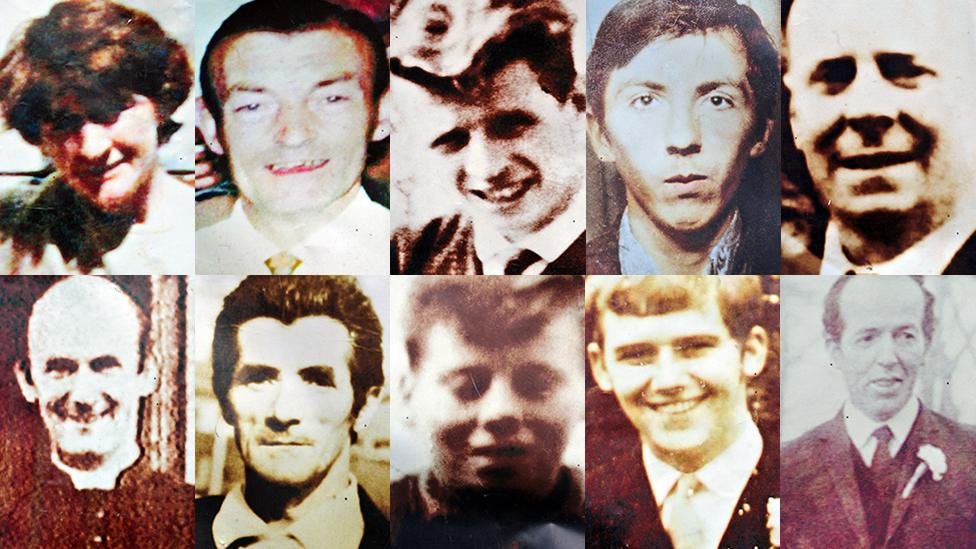Ballymurphy inquest: Paratroopers 'just opened up' on group
- Published

Nine men and a woman were killed in Ballymurphy in August 1971
Paratroopers "just opened up" on a group of people standing near their base, the Ballymurphy Inquest has heard.
The inquest is looking into the shooting dead of 10 people in the Ballymurphy area in August 1971.
They died during the first few days after the introduction of internment.
Four people died and several others were injured after what the inquest describes as "Incident 2".
Those who died in the shooting outside the Henry Taggart Memorial Hall, on the Springfield Road, were Joan Connolly, Joseph Murphy, Daniel Teggart and Noel Phillips.
The inquest has been listening to statements about the incident from those who are now deceased, cannot be traced or are too ill to attend and give evidence in person.
The former Henry Taggart Memorial Church Hall was being used as a base by soldiers from the Parachute Regiment.
The victims had been standing opposite, across the road in a grassy area where there had previously been the manse of a local Presbyterian minister.

Relatives and supporters gathered outside Laganside Courts ahead of the start of the inquests
Several witnesses had given statements saying that around half a dozen paratroopers emerged from the base in the evening and "just opened up" on them with their SLR rifles.
The statements explained how some parents were out looking for missing children amid the arrests by the Army and general turmoil of the first day of internment.
Paul Connolly's statement, given in recent weeks, told how his mother went to look for his sister and never returned.
'They blew her face off'
Mr Connolly cannot attend the inquest due to ill health.
He explained how the next day his father went to find her.
He later returned to the family home and said: "It's your mother, they blew her face off."
Joanie Crone's statement described how her husband Dessie had hidden in the field opposite the barracks as others were around him were shot and later managed to crawl to safety, despite continuing gunfire from the army base.
Two men described hearing a child crying in the darkness and how they managed to persuade him to crawl through a fence to safety.
The boy, Edward Butler, had been shot in the leg but survived, and is expected to give evidence in person in March.

Who were the victims?
Father Hugh Mullan, 38, and Francis Quinn, 19, were shot in an area of open ground behind Springfield Park
Daniel Teggart, 44, Joan Connolly, 44, Noel Phillips, 19, and Joseph Murphy, 41, were shot near the Henry Taggart Army base near Springfield Park
John Laverty, 20, and Joseph Corr, 43, were shot at separate points at the top of Whiterock Road
Edward Doherty, 31, was shot at the corner of Brittons Parade and Whiterock Road
John McKerr, 49, was shot outside the old Corpus Christi Parish

Joseph Murphy's widow, May, described talking to him in hospital after the shooting, before his condition worsened, and he later died.
He described being taken into the base, and being beaten and kicked, with rubber bullets being fired into his body at point blank range.
Mr Murphy told his wife that his wounds, and those of others, were only dressed after the intervention of a younger soldier and an Army padre also in the base.
Willie Ward's statement described how he ran to safety with others, only noticing later that he had been shot in the shoulder.
He sought treatment from his doctor, his statement said, but had not gone to hospital, because he had heard that anyone with a gunshot wound was being interned as a matter of course.
None of the statements contained any reference to a weapon being held by anyone in the area immediately opposite the barracks when the shooting began.
At the time. the Army told journalists that the soldiers had responded to gunfire and had shot gunmen, something the families of the victims have consistently denied.
Anonymity and screening
Later the coroner heard submissions on the issue of future military witnesses at the inquest.
Seven former soldiers called to give evidence have applied for anonymity and screening during proceedings.
Another soldier appeared under such conditions at the inquest in 2018, although relatives of the man he admitted shooting, Edward Doherty, were permitted to see his face while he gave evidence.
The barrister for the Teggart and Phillips families suggested to the coroner that the risk to the lives of some of the former soldiers giving evidence was "vanishingly small".
He said screening and anonymity was not necessary.
He asked of former soldiers, called to testify: "Is there a single incident or instance in judicial proceedings in Northern Ireland of a witness being threatened, let alone being actually attacked or physically assaulted in any way?
"There aren't any."
Other barristers endorsed his comments.
The barrister for the Murphy family said some of the applications by former soldiers were "straight out of the theatre of the absurd".
However, using recent statistics of terrorist attacks, a barrister for the Ministry of Defence argued that the risk to former soldiers was "real and continuing".
Counsel to the inquest suggested that each military witness should be asked if he or she desires to be screened from the next of kin.
The court heard that this process has already begun.
- Published5 February 2019

- Published19 November 2018
